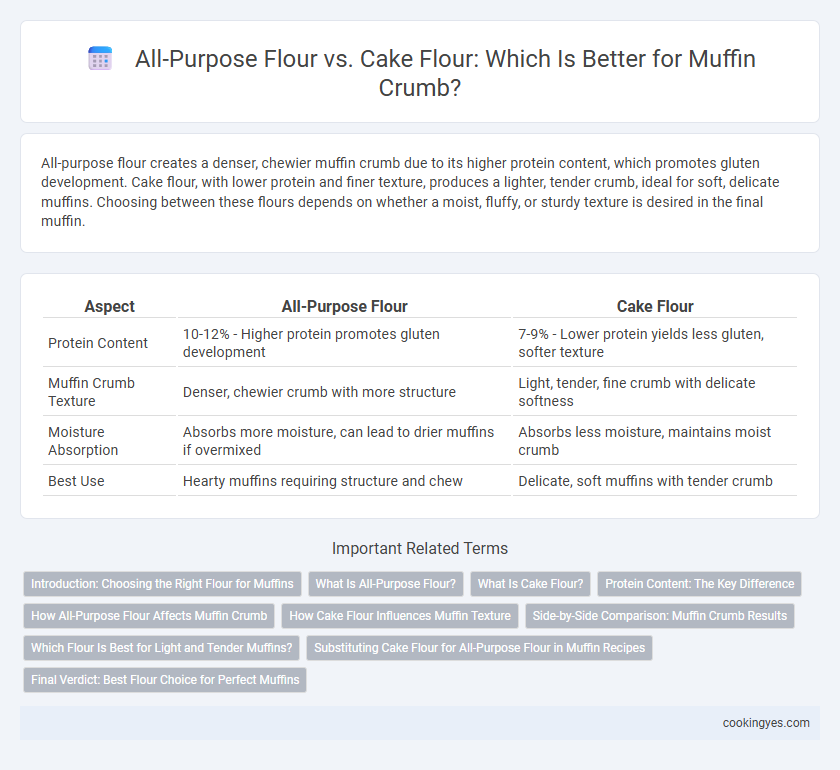All-purpose flour creates a denser, chewier muffin crumb due to its higher protein content, which promotes gluten development. Cake flour, with lower protein and finer texture, produces a lighter, tender crumb, ideal for soft, delicate muffins. Choosing between these flours depends on whether a moist, fluffy, or sturdy texture is desired in the final muffin.
Table of Comparison
| Aspect | All-Purpose Flour | Cake Flour |
|---|---|---|
| Protein Content | 10-12% - Higher protein promotes gluten development | 7-9% - Lower protein yields less gluten, softer texture |
| Muffin Crumb Texture | Denser, chewier crumb with more structure | Light, tender, fine crumb with delicate softness |
| Moisture Absorption | Absorbs more moisture, can lead to drier muffins if overmixed | Absorbs less moisture, maintains moist crumb |
| Best Use | Hearty muffins requiring structure and chew | Delicate, soft muffins with tender crumb |
Introduction: Choosing the Right Flour for Muffins
All-purpose flour provides a balanced protein content of 10-12%, contributing to a denser, chewier muffin crumb ideal for hearty flavors. Cake flour, with its lower protein level around 7-8%, produces a lighter, more tender crumb resulting in softer, airier muffins. Selecting the right flour impacts muffin texture significantly, with all-purpose enhancing structure and cake flour emphasizing delicacy.
What Is All-Purpose Flour?
All-purpose flour is a versatile wheat flour with a moderate protein content of about 10-12%, making it suitable for a wide range of baked goods, including muffins. Its balanced protein level helps develop enough gluten to provide structure while maintaining a tender crumb. Using all-purpose flour in muffin recipes creates a moist and slightly denser texture compared to cake flour, which has lower protein and yields a lighter, finer crumb.
What Is Cake Flour?
Cake flour is a finely milled, low-protein flour typically containing 7-8% protein, which produces a tender, delicate crumb in muffins. Its lower gluten content compared to all-purpose flour results in softer texture and finer crumb structure, ideal for light and airy muffins. Using cake flour instead of all-purpose flour reduces density and promotes moisture retention for a more tender bite.
Protein Content: The Key Difference
All-purpose flour contains 10-12% protein, creating a denser muffin crumb with more structure, while cake flour has 7-9% protein, resulting in a lighter, softer texture ideal for tender muffins. Lower protein in cake flour means less gluten formation, producing a delicate crumb that melts in the mouth. Choosing the right flour based on protein content directly influences muffin crumb consistency and overall baking outcome.
How All-Purpose Flour Affects Muffin Crumb
All-purpose flour creates a denser, chewier muffin crumb due to its higher protein content, which develops more gluten during mixing. This increased gluten formation results in a sturdier texture, making muffins more resilient but less tender compared to those made with cake flour. Bakers seeking a balanced crumb often choose all-purpose flour for muffins that hold their shape well without becoming overly soft or crumbly.
How Cake Flour Influences Muffin Texture
Cake flour's lower protein content, around 7-8%, results in less gluten formation compared to all-purpose flour, which contains 10-12% protein. This reduced gluten development produces a finer, softer, and more tender crumb in muffins, enhancing their delicate texture. Using cake flour creates muffins with a light, airy feel, while all-purpose flour yields a denser and chewier crumb.
Side-by-Side Comparison: Muffin Crumb Results
All-purpose flour produces a denser, chewier muffin crumb with a sturdier texture, ideal for heartier muffins, while cake flour yields a lighter, softer crumb with finer air pockets, creating a more delicate, tender bite. The lower protein content in cake flour reduces gluten formation, resulting in a fluffier muffin, whereas the higher protein in all-purpose flour promotes structure and chewiness. Side-by-side tests show cake flour muffins rise slightly higher with a more uniform crumb, whereas all-purpose flour muffins have a coarser texture and more pronounced chew.
Which Flour Is Best for Light and Tender Muffins?
Cake flour, with its lower protein content (around 7-9%), produces a lighter and more tender muffin crumb by reducing gluten formation compared to all-purpose flour, which has a higher protein content (10-12%) and creates a denser texture. Using cake flour enhances muffin softness and moisture retention, resulting in a delicate crumb structure ideal for tender muffins. For achieving the lightest, fluffiest muffins, cake flour is the preferred choice over all-purpose flour.
Substituting Cake Flour for All-Purpose Flour in Muffin Recipes
Substituting cake flour for all-purpose flour in muffin recipes results in a tender, finer crumb due to cake flour's lower protein content and softer texture. Cake flour's reduced gluten formation creates a lighter, more delicate muffin crumb compared to the denser, chewier texture produced by all-purpose flour. To maintain structure while using cake flour, adding a small amount of cornstarch or reducing the liquid slightly can help achieve the ideal muffin consistency.
Final Verdict: Best Flour Choice for Perfect Muffins
Cake flour's lower protein content creates a tender, finer crumb ideal for light, soft muffins, while all-purpose flour provides more structure and a denser texture due to higher gluten levels. For a delicate, moist crumb, cake flour is the best flour choice for perfect muffins, especially when a tender bite is desired. However, all-purpose flour works well for heartier muffins that benefit from added chewiness and volume.
All-purpose flour vs Cake flour for muffin crumb Infographic

 cookingyes.com
cookingyes.com